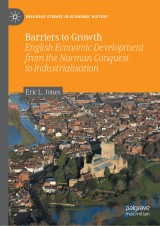Details

Barriers to Growth
English Economic Development from the Norman Conquest to IndustrialisationPalgrave Studies in Economic History
|
96,29 € |
|
| Verlag: | Palgrave Macmillan |
| Format: | |
| Veröffentl.: | 04.04.2020 |
| ISBN/EAN: | 9783030442743 |
| Sprache: | englisch |
Dieses eBook enthält ein Wasserzeichen.
Beschreibungen
<p>This book deals sequentially with major impediments to economic growth and their slow dissolution. It is original and quite different from standard economic history, which has always sought for one prime mover of the industrial revolution after another. These supposed positive forces are usually depicted as novel and little reference is made to inertia. Instead the barriers dealt with here run, in the first section, from early misallocations of resources to nineteenth-century reforms which of their nature indicate the problems to be overcome. The second section deals with more physical impediments and shocks, such as floods and settlement fires. These too are ignored in ordinary treatments, which this book will supplement or even replace. It will be of interest to academic economic historians and practitioners of neighbouring subjects such as economists, historians, historical geographers, and of course their students.<br></p>
<p>Part One. The Erosion of Obstacles.- 1.Barriers and Push Forces.- 2. Military and Ecclesiastical Buildings.- 3. Dissolution of the Monasteries.- 4. Civil War.- 5. Communal Farming and Under-used Land.- 6. Tithes.- 7. Archaic Institutions.- 8. Obstructive Infrastructure.- 9. Maladministration.- Part Two. Coping with Shocks.- 10. Disease.- 11. Insults to agriculture.- 12. Storms and adverse seasons.- 13. Floods.- 14. Fires.- Conclusions.</p>
<b>Eric L. Jones</b> is Senior Fellow at the University of Buckingham, UK.<div><br><br></div>
<p>This book deals sequentially with major impediments to economic growth and their slow dissolution. It is original and quite different from standard economic history, which has always sought for one prime mover of the industrial revolution after another. These supposed positive forces are usually depicted as novel and little reference is made to inertia. Instead the barriers dealt with here run, in the first section, from early misallocations of resources to nineteenth-century reforms which of their nature indicate the problems to be overcome. The second section deals with more physical impediments and shocks, such as floods and settlement fires. These too are ignored in ordinary treatments, which this book will supplement or even replace. It will be of interest to academic economic historians and practitioners of neighbouring subjects such as economists, historians, historical geographers, and of course their students.<br></p>
Provides a unique approach to economic growth by considering the removal of obstacles rather than seeking yet another push force Emphasizes coverage of institutional change combined with treatment of ‘real world’ factors, including natural disasters largely ignored in works of economics/economic history; this should attract historical geographers and provide background to climate change Covers an unusually long chronological span
<p>“Jones’s thesis is that the cumulative growth of national wealth over six centuries after the Norman conquest cannot alone be explained by innovations in production. Overcoming obstacles and dealing with shocks was as important in shaping economic development. <i>Barriers to Growth </i>asks us to look again at the historical record, to focus on themes which have received little attention or only specialised interest. A revised framework for interpretation emerges when the themes are woven into standard historical explanations.”</p>
--Patrick Dillon, Emeritus Professor, College of Social Sciences and International Studies, University of Exeter</p>
<p> </p>
<p>“This book sees modern economic growth as a removal of institutional and environment barriers that held it back before the Industrial Revolution and which were gradually and unevenly relaxed at some point in the Age of Enlightenment and after. The barriers to growth before the Industrial Revolution were inertia and resistance; above all these had to be overcome. This is a work not just of erudition but of wisdom.”</p>
<p>--Joel Mokyr, Robert H. Strotz Professor of Arts and Sciences and Professor of Economics and History, Northwestern University</p>
</p>
<p>‘… a highly original and thought-provoking perspective on a major topic of debate for economic history. It challenges the existing debate by broadening its focus, drawing into the heart of the argument a welter of subtle changes that slowly transformed how markets and the flow of capital altered during the two or three centuries before the so-called take-off of the English economy”</p><p>--Robert Dodgshon, Emeritus Professor, Department of Geography and Earth Sciences, Aberystwyth University</p>
--Patrick Dillon, Emeritus Professor, College of Social Sciences and International Studies, University of Exeter</p>
<p> </p>
<p>“This book sees modern economic growth as a removal of institutional and environment barriers that held it back before the Industrial Revolution and which were gradually and unevenly relaxed at some point in the Age of Enlightenment and after. The barriers to growth before the Industrial Revolution were inertia and resistance; above all these had to be overcome. This is a work not just of erudition but of wisdom.”</p>
<p>--Joel Mokyr, Robert H. Strotz Professor of Arts and Sciences and Professor of Economics and History, Northwestern University</p>
</p>
<p>‘… a highly original and thought-provoking perspective on a major topic of debate for economic history. It challenges the existing debate by broadening its focus, drawing into the heart of the argument a welter of subtle changes that slowly transformed how markets and the flow of capital altered during the two or three centuries before the so-called take-off of the English economy”</p><p>--Robert Dodgshon, Emeritus Professor, Department of Geography and Earth Sciences, Aberystwyth University</p>
Diese Produkte könnten Sie auch interessieren:

Supply Chain Management: Models, Applications, and Research Directions

von: Joseph Geunes, Panos M. Pardalos, H. Edwin Romeijn

149,79 €















